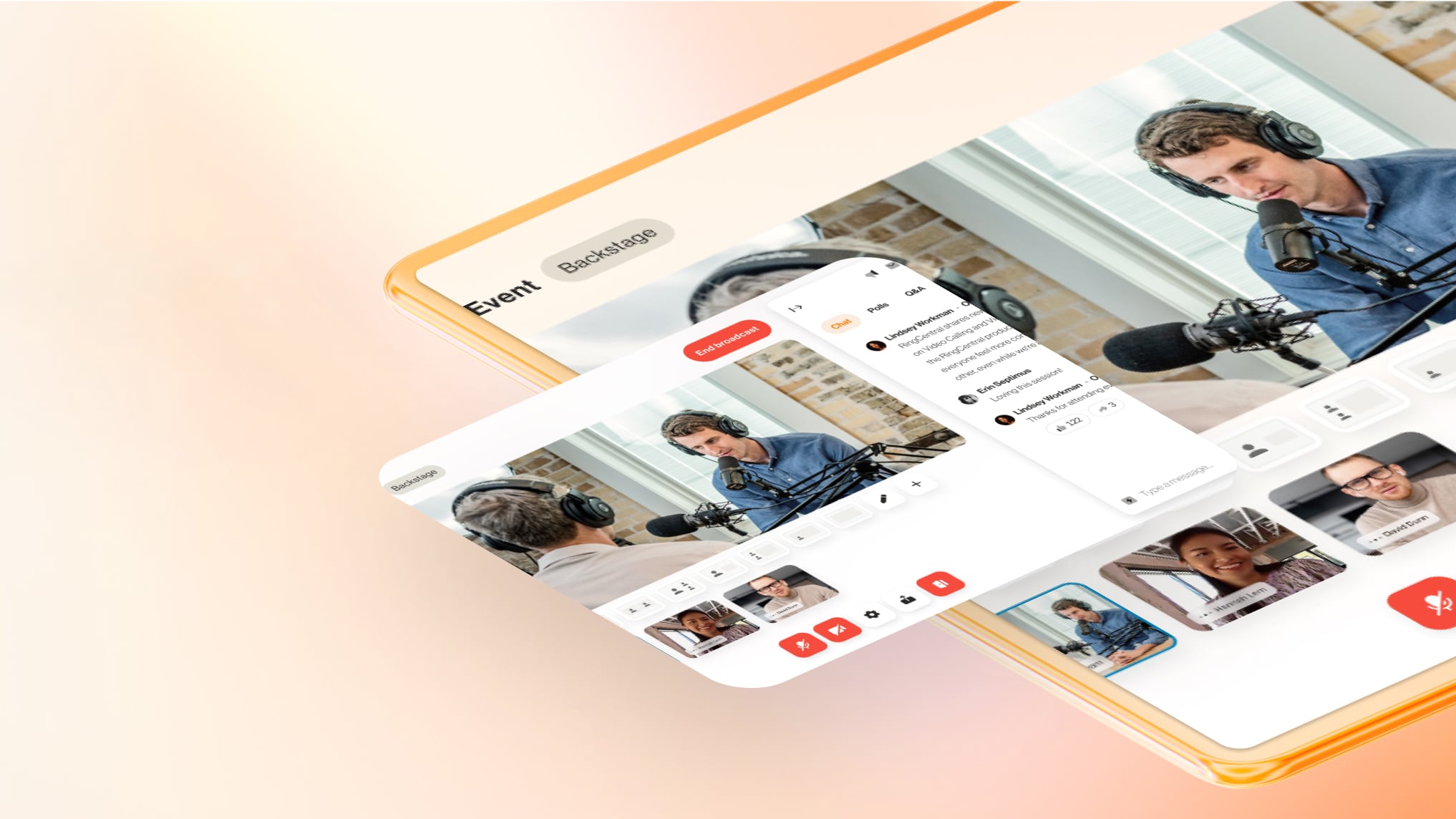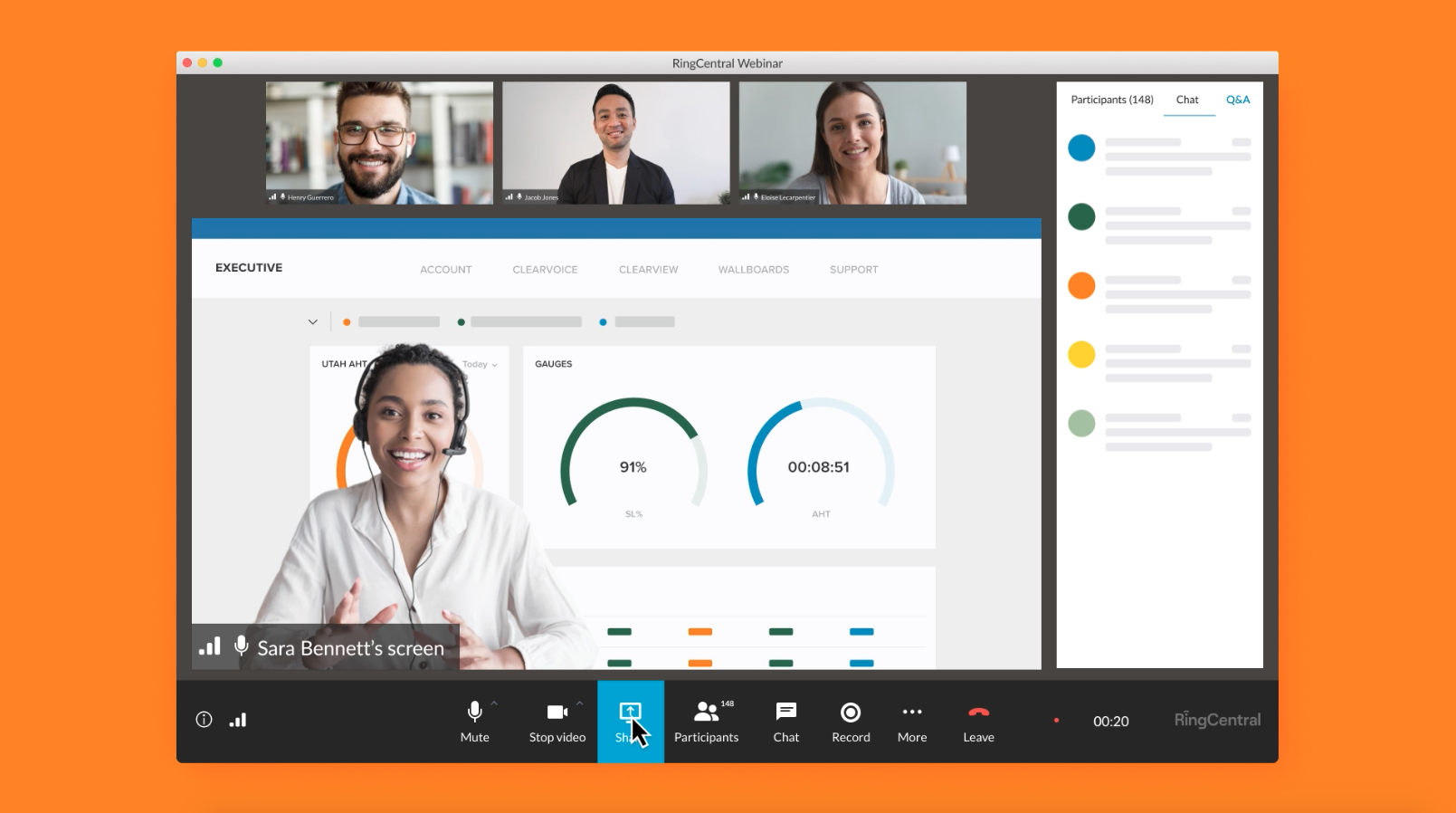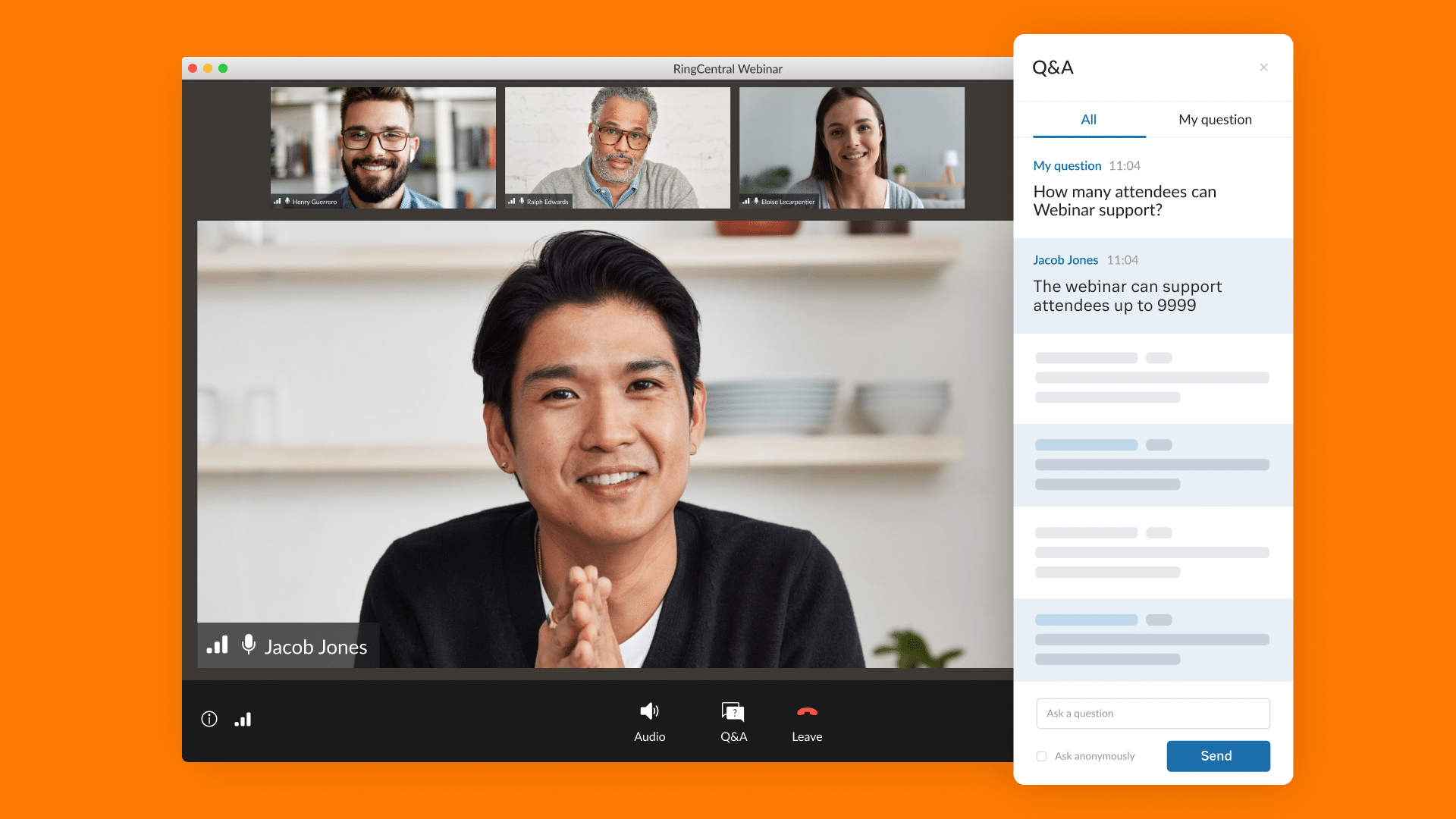Hopin is now RingCentral Events.
“It starts off with a bang, and then we’ll maybe host a talk, and then a break, maybe networking, or an interactive talk? When do we serve coffee? It seemed so clear in my head”.
This may sound pretty familiar for first time event organizers (and occasionally the seasoned ones too): trying to transform the list of ideas into a coherent plan.
But putting in the time to plan is worth it:
- Virtual and hybrid events allow event planners to access greater reach and increased sponsorship opportunities at a reduced cost, with a large majority (79%) of companies planning to host hybrid events this year.
Hybrid events are a little bit like a magical pair of jeans that fit and look great on everyone. (Sisterhood of the Hybrid Event does have a nice ring to it, doesn’t it?)
But while hybrid events can drive high engagement and wide reach while reducing physical and financial barriers, unfortunately they’re not actually magic. They have to be made — one stitch at a time.
Maximizing the impact of your hybrid events requires following a blueprint for success. In this article, we’ll go through what each state of that process looks like, as well as how to put it all together.
What is a hybrid event?
A hybrid event combines in-person and virtual experiences to create an immersive space and interactive dialogue for all attendees — regardless of whether they join and participate in-person or online.
There are three components that can make an event hybrid:
- It includes a variation of in-person and online experiences
- Online and on-site attendees can interact with presenters, sponsors, and their fellow event community
- Event content is at least partially live
Because this event format is unique, it requires an event checklist that’s a little different than your in-person or virtual event planning checklist.
Event planning: 3-6 months before your event
When would you like to have your event? If you haven’t decided yet, give yourself a few months if possible.
Having 3-6 months of lead time allows you to get thoroughly organized and get your event planning kicked off the right way. Here’s where to start:
Set your goals, KPIs, and measures for success
Set a vision:
Before you start planning, you want a clear sense of why you’re doing all this work. Looking through a strategic business lens:
- What do you want to accomplish with this event?
- Why host this event?
- What value can you provide your audience?
- How do you envision creating attendee value will impact your organization?
Determine strategic goals:
Like any other investment, it’s ideal to have a goal, or business impact, defined for your event beforehand to measure your efforts against.
Common business outcomes and goals include: increasing brand awareness, generating leads, contributing to pipeline revenue, driving sales, and boosting media and analyst coverage, among others.
Identify quantitative Key Performance Indicators (KPIs):
What KPIs will you attach to those strategic goals? That’s how you’ll actually measure how you’re tracking toward success. Which metric will be the most important to you?
Maybe you’ll be monitoring the number of registrations, attendees, traffic to your website, social mentions and followers, MQLs, influenced pipeline dollars, or a combination.
Define your audience
Know who your event is for:
Develop a target audience for your event by creating attendee profiles, or personas.
Understand why they’ll be interested in your event:
At the end of the day, each decision you make should focus on creating value for your attendees — the speakers you select, the sponsors you attract, the content and programming you choose, and the online or in-person environments, or experiences, you create.
What’s in it for each of those groups?
Dig into data:
You can leverage primary audience data (like insights from your event platform) as well as secondary sources (like research and surveys).
Data-driven insights from prior events can help inform the most popular topics, key influencers, impactful speakers, and more. Consider information around attendees’ professional roles, overall demographics, needs, pain points, and the like.
Determine your budget
An early budget should provide initial parameters and identify all expenses that carry an actual cost. Start by adding line items and anticipated costs to a spreadsheet, and be sure to leave some wiggle room for any necessary but unanticipated costs.
Update your budget as your planning progresses:
Adjust each associated line item expense in your budget as more details become available. That way, you can keep a pulse on your event’s total spend relative to your initial budget throughout the planning process.
Provide transparency to your stakeholders as your budget evolves:
Identify the key leaders and stakeholders for your event and make sure you’re aligned on budgetary expectations.
Build your event team
Given that hybrid events cater to both in-person and online audiences, it’s best to have two teams helping you bring them to life — one dedicated to each event experience.
Taking this approach to staffing helps avoid a common hybrid event pitfall, wherein organizers find themselves and their team spread thin when the live show commences.
You’ll also want to take diversity into account. A team that includes a range of backgrounds and perspectives can surface new ideas and help guard against blind spots that can affect the success of your event.
Key roles and functions to consider:
- Communication and coordination within your team and with partners, sponsors, speakers, and attendees.
- Marketing and copywriting support for pre, during, and post-event promotion via email, social media, online advertising, and other common event marketing channels.
- Event production and design for planning and logistics and to ensure the day of your live event runs smoothly, including:
- Virtual and on-site hosts to be the attendee advocates and ensure the event experience is informative and engaging for all.
- Emcees, moderators, and chat managers for support in bridging the audiences and who are responsible for including both virtual and in-person attendees in session chats, live speaker Q&A, and more.
- Technical support for attendees, sponsors, and speakers for both pre-, during, and post-event guidance and help.
- Source an agency and A/V partner to support planning, execution, and production, if or as needed.
- Pro tip: If this is your first time running a hybrid event, you may want to consider partnering with a professional A/V (audio/visual) company to support filming, recording, and leveraging RTMP technology for live streaming your event.
Set regular meetings with your event team for alignment and progress:
Check in with your event team and stakeholders throughout your planning process to keep all parties updated and on the same page. If you make event changes, be sure to communicate revisions and updates to your team.
Source event sponsors and partners
When attracting sponsors for hybrid events, focus on how this event format is often more profitable for sponsors and partners than the traditional, purely on-site event model. Make sure you highlight that hybrid sponsors will benefit from:
Deep attendee insights:
Combining virtual experiences with on-site events comes with another key benefit for sponsors and partners: attendee-level data and reporting.
Set sponsors up for success by choosing a best-in-class event management platform with robust, individual-level insights to help your key partners understand which attendees have expressed active interest in their offerings.
Increased reach:
Compared to in-person events alone, adding a virtual attendee component significantly expands the size of the audience that event sponsors and partners can reach, attract, and convert into customers.
See how The Women In Product Conference leveraged this approach to online event sponsorship with record-setting feedback and the results their team and sponsors received.
Choose an event theme and subject
You want your audience to be actively excited about attending your event. That means you’ll need to conduct research to determine what topics resonate with them.
- Leverage past event data and insights whenever possible to help you understand the most popular topics and engaging content to inform what high-resonance themes and topics to focus on for your next event.
- Utilize common tools, like social media, keyword search volume, and top publications your audiences follow to find out what topics are trending and are likely to maximize attendee value.
- Conduct attendee and customer surveys to ask your potential audience what they would value most in terms of the topics, content, and programming for your event.
- Ask industry experts or past event influencers for advice on event content and topics. They can function as an invaluable resource for helping you keep a pulse on what your attendee audience values and desires.
Define your event program and type
Internal or external:
Will this be a hybrid event for your internal team, like a sales kick-off, cultural celebration, or an all-hands meeting? Or, will it be external and open for public attendance?
Audience size:
What proportion of your attendees will attend your hybrid event onsite or virtually?
- In-person audience: How many participants can be onsite safely? How might this affect your decisions on ticket pricing (if paid) and/or which locations will best accommodate your event?
- Online audience: Is there a set capacity for virtual attendees? Ideally, the online audience can help expand the overall reach and attendance of your event, but sometimes, you may opt to keep your online attendee size under a certain threshold based on your unique event’s needs. If the former is of interest, be sure to check with event management platforms to ensure they can handle the scale of the virtual portion of your event.
Type of event:
Almost any event can be a hybrid event, but it’s good to keep in mind how each type functions. Here are examples of different types of events and some primary considerations for each:
- Conference or summit: What is the theme, scale, and design of your event? This will inform attendees’ overall experience — from the way they interact with your brand to their decision to attend. Choose a theme and format that helps you stand apart from the competition and be readily prepared for the total volume of speakers, attendees, and events.
- Trade show or expo: How can you foster exhibitor and attendee experiences to optimize the event for all? Effective event marketing can draw in the right attendees to help exhibitors achieve revenue goals, while virtual and in-person opportunities can increase show participation, and built-in event platform data and analytics can offer valuable information to vendors.
- Career and recruiting fair: How will you create moments of interaction both virtually and in-person? This type of event is all about person-to-person connection, so you want to make sure clear and effective communication is possible for every participant. Set attendees up for success with thoughtful instruction on how to come prepared with résumés and other materials, and help your business (and/or other employers) find the best candidates.
- Training or educational workshop: Have you incorporated a sequenced communication plan into your event plan? Make sure you have the right staff and event platform to contact registrants at multiple stages of their event journey. That way, you can send reminders, provide event details and instructions, answer questions, and send follow-up messages to build relationships, as attendees seek to engage in educational opportunities.
- External-facing meetings: How can you showcase your organization in the best light? For meetings with clients, customers, and other outside attendees, you want to create a seamless experience that incorporates your event’s branding, values, and offerings, leaving participants with a great impression and understanding of your company.
Types of sessions to include:
What kind of program content will you have?
You can include keynotes, panel discussions, fireside chats, workshops, product demos, customer spotlights, and more. Will your programming vary for in-person attendees or for online participants? Or, will the event experience and sessions remain the same for both hybrid event audiences?
- Pro tip: Remember to focus equally on creating value for each and every attendee, regardless of their location.
Engagement opportunities during the overall event and individual sessions:
- For in-person attendees: Consider how and where participants will interact with one another, their virtual attendee peers, and presenters onsite.
- For online attendees: How will you bridge the gap between in-person attendance and those joining remotely?
Breakout rooms, online video networking, group brainstorming exercises, and the like, can serve as great ways to both engage attendees and connect them to their event community’s peers, whether online or onsite.
Craft an event title, pitch, and description
Like all event planning decision-making, be sure to keep your attendee audience front-and-center at all times to ensure your event will hit the mark.
When naming your event, consider what will excite your audience and be memorable. When in doubt, keep it simple.
To formulate your elevator pitch, create a short 30-second to one-minute statement that concisely describes why your event will provide attendees with unparalleled value, if they attend. And don’t forget to test it out and gather feedback for refinement.
To help create your event description, leverage the work you did to prepare your pitch and incorporate any feedback you may have received. Your event description should communicate what the show is all about, who it was created for, and what value attendees can expect to receive from attending your hybrid event.
- Pro tip: Be sure to make your first impression with prospective attendees count. Learn more about how to create stunning event websites, as they can play a significant role in your hybrid event success.
Determine event date, time, and duration
Before you lock down your event date, be sure to check for any conflicts:
- Ask yourself: Are there any competing events, or holidays, on or near the same date? Are there seasonality or weather-related concerns? Will speakers, sponsors, and internal event team members be available on the date(s) you select?
Book speakers, presenters, and special guests
Secure in-demand talent and presenters early:
If necessary, you can offer top-billed speakers the option to present virtually — this will remove or reduce the friction of travel, scheduling, and other barriers.
Be sure to clearly state the value to your invitee and lay out the essential details about your event. Additionally, be sure to set expectations upfront, and aim to stay in close communication around logistics, presentations, and the like.
Set ticketing and pricing structure
The first thing to do is to decide if attendance will be free, paid, or a combination of both with ticketing tiers. From there you can determine pricing packages for both in-person and online attendance.
Offering both free and paid tickets for online and in-person attendees is common in event organizing. Often, event professionals will create premium, or VIP, experiences, which can be made available for an additional cost. Similarly, some hosts opt to charge for tickets to attend onsite.
This type of approach makes your event more flexible and accessible — while also upping your earning potential, so you can tap into both ticket revenue and sponsor revenue.
Decide on content delivery for virtual experiences
Content can be one of the most powerful mechanism to attract and retain your audience.
How will you produce your program content? Will it be all live, simulated-live, or pre-recorded?
Often, event organizers will employ a combination of these content delivery formats for their hybrid events. This is where it can be helpful to consult an A/V partner, depending on the level of complexity involved and your internal staff members’ areas of expertise.
Select a physical venue
You’ll want to research release and general liability needs for on-site participants.
- Reach out to local health authorities to obtain the most up-to-date information on COVID-19 operating status and restrictions.
- Build a safe, on-site plan according to local public health rules and regulations.
- Understand your COVID-19 testing vendor’s process, as applicable, including any legal- or security-specific requirements or considerations.
- Ask yourself: What specific forms and waivers will you and/or on-site participants need? How will you track completion and the results of testing protocols, or vaccine passports, if or as applicable?
Choose an all-in-one event management platform
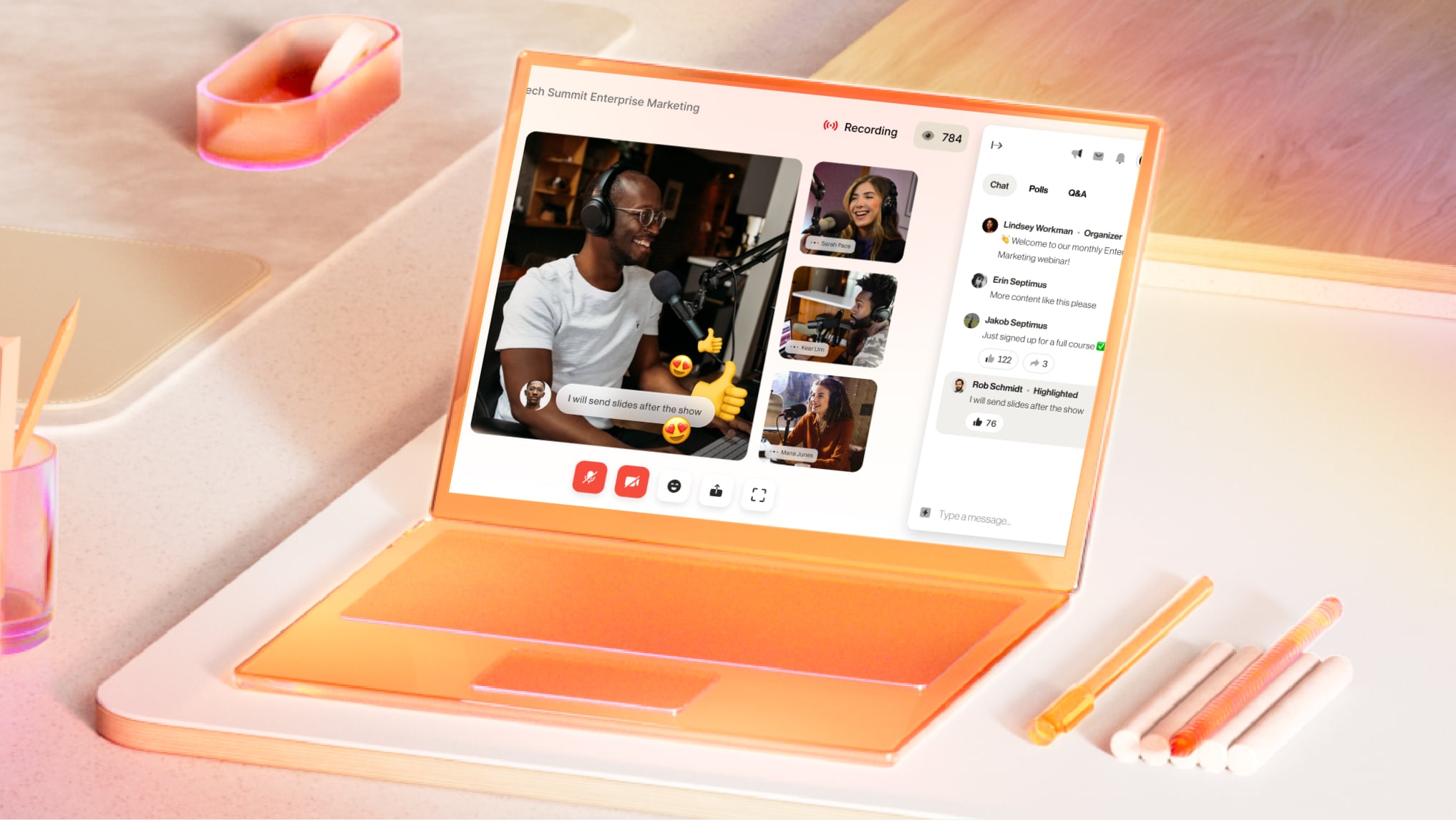
Hosting a successful hybrid event means choosing the right technology along the way.
Evaluate your event management platform solution by asking questions that include:
- Scalability: How many attendees can the platform accommodate? For example, will the platform itself be able to handle the scale of a large event with 100,000 attendees?
- Multiple virtual spaces: Does the platform support various stages, concurrent sessions, scheduled meetings, and breakout rooms? Can I build out unique experiences for my attendees or empower them to do the same, if desired?
- Ease-of-use: Will I, as an organizer, be able to easily use the platform to set up and run my hybrid event without needing to rely on coding or engineering support? Is the platform easy to use and intuitive for attendees to navigate in order to avoid premature drop-off and unnecessary confusion among event participants?
- Interactive features: Does the event platform provide multiple ways for attendees to interact with one another, sponsors, and speakers, using capabilities such as socially driven chat, emoji, gifs, polls, Q&A, upvoting, photo booths, collaboration tools, and the like?
- Networking features: Will the platform be able to facilitate meaningful networking opportunities for attendees? Does it provide multiple options for attendees to connect and engage, like via 1:1 video networking, breakout rooms, private messaging, scheduled meetings, attendee profiles, and mutual exchanges of contact info?
- Advanced registration: Does the event platform allow for multiple ticket types, bulk ticketing, VIP registration, referral codes, custom form fields, and the like, to support the hybrid event you’re hosting? If necessary for my internal process, do I have the option to use other integrated systems, like Salesforce or HubSpot, to manage registration, which will automatically sync with the event platform itself?
- Support: Will I have access to the support I need to set up and run my live event using a platform? Are there options where I can opt for additional support, if or as needed? Does the vendor provide a comprehensive knowledge base for customers, as well as event platform tutorials and workshops to support my ongoing success?
- Branding options: Can I customize the look and feel of the event platform to reflect my company or event’s unique brand? Will I have the option to customize the online and mobile event environment to ensure I can make a visual brand impression for my attendees?
- Sponsor experience: Will the event platform provide ways for sponsors to drive interest in their offerings? Does it offer tiered-sponsor capabilities? Can sponsors customize their own expo areas with content, CTAs, videos, images, downloads, and more? Can attendees schedule meetings and meet with sponsors live, both online and in-person?
- Event analytics: Will the event platform provide me with detailed reports and attendee-level data for me to use to optimize the event experience, provide measurable value to sponsors, and inform my marketing and sales efforts?
- Live streaming: Does the event platform provide built-in streaming and RTMP support for live video casting my hybrid event sessions? Will it provide advanced video streaming functionality, like practice rooms for speakers, green screen backgrounds, and support for pre-recorded and on-demand video content?
- Integrated apps: Does the technology vendor offer pre-built integrations that I might want to leverage for my event, such as gamification tools for contests and giveaways, ways to raise funds for charitable causes, closed captioning, multi-language translation, and more?
Aim to implement the event management platform that you choose at least one month before your event, if possible. This will give you time to familiarize yourself with your event platform, set up all event content, and allow for dry-runs prior to the live event.
Develop event branding and creative
A cohesive visual identity that translates across in-person and online parts of your event will help make all participants feel like they’re part of what you’re creating.
Gather or create assets for branding your hybrid event, including:
- Logos
- Tagline
- Description
- Event website visuals
- On-site signage
- Printed or digital collateral
- Physical venue designs
- Custom swag or giveaways
- Online event graphics
Event production: 1-3 months before your event
As you get closer to the start of your event, it’s time to build on the groundwork you’ve laid over the course of previous months. Start focusing more on your content, promotion, and the finer details of the event.
Finalize event agenda
Schedule sessions, breakouts, and keynotes:
Detail what type of content, as well as how and when it will be delivered in-person, online, or both.
Create event website and registration
Use your event platform to create an easy-to-use website for attendees to learn more about your event, purchase tickets, or register.
Keep your event website updated with the latest information as you get closer to the big day. That way, you can ensure you are keeping your attendees up-to-date with the latest changes and avoiding missing out on any potential additional registrations.
Set up and customize your online event environment
Build out your virtual venue:
=Use your event platform to create the stages, sessions, breakout rooms, expo areas, networking opportunities, RTMP and live streaming settings, and more, all of which you may need to present your content and create an immersive and engaging attendee experience.
Remember to include branding, logos, and colors you want to integrate into your interactive event.
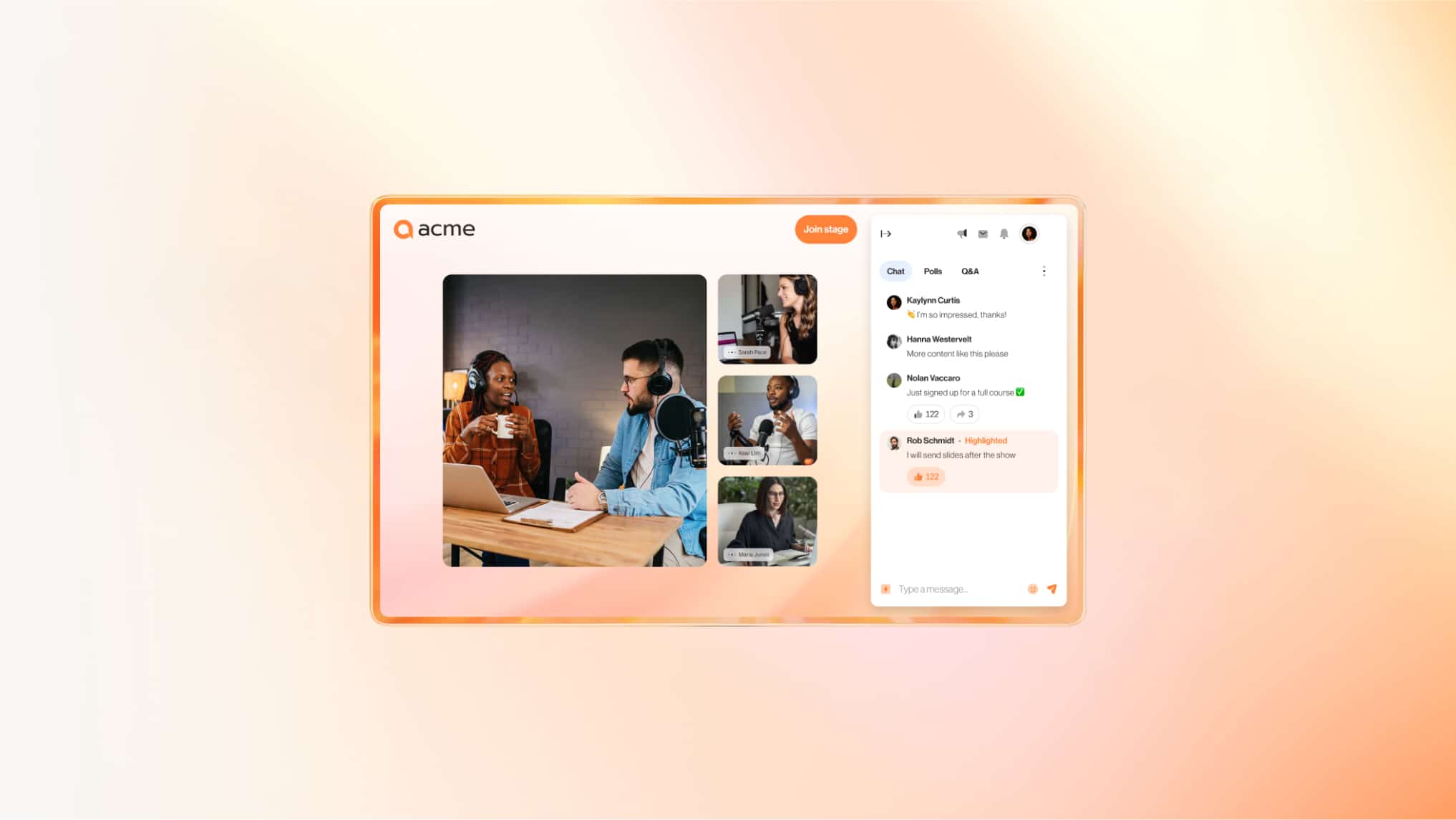
Sponsors
Determine your sponsorship or exhibitor plan
You will want to have a plan for both the in-person and virtual experiences.
Create sponsorship packages that include both on-site and online opportunities and craft your sponsor kit, or prospectus, and sponsor outreach materials to outline the value, or business results, your sponsors can expect to receive by participating.
From there you can create a sponsorship contract with agreed-upon terms and conditions from your legal team. Obtain signatures and ensure expectations are aligned in writing for all parties.
Provide your sponsors or exhibitors with set-up instructions
Include detailed instructions on preparing and shipping needed materials for their sponsorship and on how to interact with attendees who visit their expo areas.
Equip the sponsors and exhibitors with promotional toolkits
Ask them to promote the event to their own networks and customers. This will go a long way toward helping you increase your audience and attract additional attendees to your hybrid event.
Technical considerations
When hosting a hybrid event, you must consider the tech for both onsite and virtual elements. Things to keep in mind may include:
- A/V equipment and live streaming
- On-site check-in kiosks and QR codes (QR Codes can be easily created using a QR Code Generator)
- Technical set up for on-site presenters
- Venue-specific power and electric
- Strong internet connections at your physical venue
- On-site badge printing and scanning
- Health and safety screening tools
- Online and on-site lead capture for sponsors
Promotion
Create an audience acquisition or marketing plan:
Consider the channels you’ll use for event promotion, such as email, social media, paid ads, influencer and partner marketing.
Make sure to include a CTA (call-to-action) that drives your audience to the event platform or website with built-in, integrated registration, so you can capitalize on interest immediately.
Set up and decorate your physical event venue:
Incorporate the same branding, logos, designs, and colors you used to set up your virtual venue and event website using your event platform for a cohesive and consistent look and feel.
Content
Focus on quality over quantity and include a variety of content types to appeal to your audience. Employ storytelling, and think of creative ways to elicit emotional reactions to your content to help form a lasting connection with your attendees.
Produce event content:
Create any pre-recorded video content, activations, slides, etc., prior to the event itself, as this will save you the headache of trying to do so at the last minute.
Coordinate live event content:
Remember to prepare your moderators, speakers, and presenters for success and be sure to share your run-of-show. If they’re joining remotely, make sure your presenters have had a tutorial on how to use any tools or software they’ll need.
Provide technical support:
Have technical teams trained and ready to support online and in-person participants, as needed, during your event.
When possible, try to arrange for dry-runs, or practice sessions, with key stakeholders prior to the hybrid event.
This can help moderators, hosts, speakers, and presenters feel confident and at ease on the day of your event, and ensure the live show is smooth and seamless for all involved. Also, look to leverage your event platform’s pre-event check tool, which helps make sure your speakers’ audio, cameras, and internet connections are ready to rock.
Audience engagement
Create online engagement touchpoints for before, during, and after the event. Some interactivity-driven elements to consider for your hybrid event include:
- Videos
- Surveys
- Polls
- Chat
- Networking
- Q&A
- Trivia
- Photo booths
- Contests
Determine on-site engagement opportunities.
Look for ways to bring online and in-person audiences together to connect and interact, so your hybrid event fosters an inclusive community for all attendees.
Provide attendees clear instructions
for participation via the online event platform, so they can confidently join or navigate the event.
- Pro tip: Record a quick tutorial video for your attendees to access prior to the event that walks them through how to log in or check in to the event, how to navigate the event itself, and other relevant guidance.
Monitor and moderate online audience feedback
This can be in the form of questions, comments, and ideas and can help bridge the gap between virtual and in-person content. Share audience input with speakers and presenters backstage to inform the content in real-time.
Post-event
Congratulations! Almost, that is.
Your live event has wrapped, but the work isn’t over quite yet.
The final part of your hybrid event checklist should focus on learnings you’ve gathered from your event and building a post-event community to help you market in the future.
After some well deserved team celebrations, review event analytics in your event platform:
- Measure success against your event goals and KPIs by analyzing your event attendance rate, NPS score, demographic breakdown, ROI, and any other quantitative KPIs you set up pre-event.
- Set up a debrief meeting for your team to discuss learnings and takeaways from the event to inform future optimization.
- Share lead data and insights with marketing and sales teams for relevant and personalized follow-up.
- Track conversions, revenue, or other key outcomes of attendees-turned-customers after the event.
Follow up with speakers, sponsors, and partners
Send thank you notes, provide recordings, and share data to demonstrate the success of your event.
Nurture your event audience to build community
Provide event recaps and recordings to your attendees. Send event participants key learnings and takeaways with links to resources, downloads, or recorded sessions.
You can then send thank you emails, or cards, to express your gratitude for their participation and encourage their continued attendance at future events. Be sure to also conduct post-event surveys to help shape the content of your next event.
Finally, repurpose event recordings for organic and paid content marketing through avenues such as gated or on-demand content.
Blueprint extras and more
Now that you’ve got the full timeline and checklist for hosting a successful hybrid event, it’s off to the races. Sponsors, attendees, exhibitors, watch out: magic is coming their way.
But if you want to dive deeper on anything you’ve learned in this guide, we’ve got you covered for that, too.
To learn more, create a free account, or reach out to one of our amazing team members to see how we can help you create the best hybrid experience for your audience.
Originally published Sep 01, 2022, updated Oct 20, 2024
